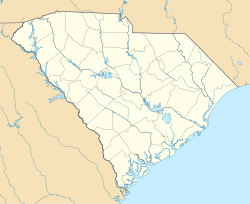Clark Mills Studio
This article needs additional citations for verification. (December 2016) |
Clark Mills Studio | |
 Clark Mills Studio | |
| Location | 51 Broad St., Charleston, South Carolina |
|---|---|
| Coordinates | 32°46′33.89″N 79°55′47.66″W / 32.7760806°N 79.9299056°W |
| Part of | Charleston Historic District (ID66000964) |
| NRHP reference No. | 66000703 |
| Significant dates | |
| Added to NRHP | October 15, 1966[1] |
| Designated NHL | December 21, 1965[2] |
| Designated NHLDCP | October 9, 1960 |
The Charleston, South Carolina studio and residence of sculptor Clark Mills (December 13, 1810 – January 12, 1883), was his first—he lived and worked there from 1837 to 1848, when he moved to Washington, DC. The Charleston studio was designated as a National Historic Landmark in 1965. Before it became Mills' studio, the building, located at 51 Broad Street, Charleston originally served as a tenement house, and now houses professional offices. In 1848, Mills moved his studio and residence from Charleston to Washington, D.C., when he won a major contract to cast the the equestrian bronze statue of Andrew Jackson—now in Lafayette Square, Washington, D.C., which made his name and foundry famous.[3][4] With the success of the 1852 Andrew Jackson sculpture, Mills studio was awarded other major contracts, created in Clark Mills Studio and Foundry in Bladensburg Road, Maryland, eight miles from the Capital in Washington.
Mills Charlston studio (1837 – 1848)
The former Mills Studio building is located Charleston's old city, on the south side of Broad Street just west of Church Street. It is a four-story masonry structure, built out of stuccoed brick. Its front facade is now commercial, with store fronts on the ground floor, projecting bay windows on the second and third floors. The interior is also reflective of its modern uses, having been converted into professional offices around the turn of the 20th century.[3] The building was originally built as a tenement house, and had two tenants in the 1830s, one of whom, Erastus Bulkeley, maintained a yard nearby from which he sold marble. When the other tenant moved out in 1837, Clark Mills rented that space, and established his residence and studio there.
It is believed that it is here that the self-taught Mills produced his first significant work, a marble bust of South Carolina politician John C. Calhoun.[3]
Mills Studio and Foundry in Washington, D.C. (1848)
In 1848, Mills Foundry was selected by the Jackson Monument Committee to create an equestrian statue of Andrew Jackson. The memorial statue to Andrew Jackson is in Lafayette Square, near the White House in Washington, D.C.[5]
For this contract Mills moved to Washington from Charleston, bringing with him eleven slaves including the master craftsman, Philip Reid, who had become Mills' apprentice. They erected a temporary foundry south of the White House for the casting. According to the Smithsonian's James M. Goode, Mills with the assistance of his apprentice, Reid and laborers, produced six castings of the equestrian statue.[6]: 377 When the bronze casting was completed in 1852, it was considered to be the "first bronze statue ever cast in America", according to The Architect of the Capitol . They had made it through "trial and error" making its "accomplishment" quite extraordinary—none of the workers, including Mills had any formal training..[7] It has been described as the first equestrian statue made in America, and possibly the first equestrian statue of a horse rearing on two legs in which no additional support was added.[8]
Clark Mills Studio and Foundry in Bladensburg Road, Maryland
The 1863 bronze Statue of Liberty was cast in Mills' large octagon-shaped studio and foundry on Bladensburg Road, Maryland.[5] This building is included in the White House Historical Association (WHHA).
See also
- List of National Historic Landmarks in South Carolina
- National Register of Historic Places listings in Charleston, South Carolina
References
- ^ "National Register Information System". National Register of Historic Places. National Park Service. January 23, 2007.
- ^ "Clark Mills Studio". National Historic Landmark summary listing. National Park Service. Archived from the original on 2011-06-06. Retrieved 2008-03-07.
- ^ a b c "National Register of Historic Places Inventory-Nomination: The Clark Mills Studio / Clark Mills Studio, Stoney and Stoney Law Office" (pdf). National Park Service.
{{cite journal}}: Cite journal requires|journal=(help) and Accompanying three photos, two exterior of the building in 1975, and one of the Andrew Jackson Memorial Statue in 1970 (32 KB) - ^ "Clark Mills Studio, Charleston County (51 Broad St., Charleston)". National Register Properties in South Carolina listing. South Carolina Department of Archives and History. Retrieved 2008-03-08.
- ^ a b "Clark Mills's Foundry". White House Historical Association (WHHA). nd. Retrieved June 23, 2020.
- ^ Goode, James M. (1974). Outdoor Sculpture of Washington, D.C. Smithsonian Institution Press. ISBN 0-87474-138-6.
- ^ "Philip Reid and the Statue of Freedom". Architect of the Capitol. Retrieved June 23, 2020.
- ^ "Philip Reid and the Statue of Freedom". Architect of the Capitol. June 2013. Retrieved June 23, 2020.
External links
- Clark Mills Studio, Charleston County (51 Broad St., Charleston) , at South Carolina Department of Archives and History
- "Clark Mills Studio", HMdb
- http://www.loc.gov/pictures/item/SC0258/



